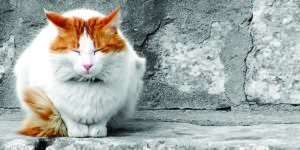FOR THE LOVE OF THE ANIMALS
By Dr. Beth Leermakers
Is your older cat slowing down? If so, arthritis may be the culprit. Arthritis (also called degenerative joint disease or osteoarthritis) is a chronic, painful, progressive condition involving the joints of cats. As in people, arthritis is commonly associated with aging.

The cartilage that normally lines and cushions the joints breaks down, allowing bones to rub together abnormally. Nearby bone may splinter and form sharp, bony projections into the joint. These changes lead to swelling, inflammation and pain in the joints.
Some cats are very stoic, hiding their pain well, so it can be difficult to tell that your cat may be suffering from arthritis. Test your knowledge about arthritis in cats.
1. What percentage of cats over 12 years old have arthritis?
A. 30-50%
B. 50-70%
C. 70-90%
2. What percentage of 6-year-old cats have signs of arthritis?
A. 10%
B. 30%
C. 40%
D. 60%
E. None of the above
3. Which of the following IS a symptom of arthritis:
A. Tiredness
B. Irritability
C. Muscle atrophy
D. Licking, chewing and biting
E. All of the above
4. Which of the following is NOT a sign of arthritis:
A. Limping
B. Poor grooming (looks unkempt)
C. Not using the litter box
D. All of the above
E. None of the above
5. True or False? Being overweight contributes to the development of arthritis in cats.
6. True or False? There is no cure for arthritis, and there is nothing you can do to slow the progression of the disease.
7. True or False? Glucosamine/chondroitin and fish oil can be helpful for arthritic cats.
8. Which of the following pain medications is NOT helpful for arthritic cats:
A. Aspirin
B. Gabapentin
C. NSAIDS (non-steroidal anti-inflammatory drugs) like Meloxicam
D. Adequan
E. Solensia
9. What alternative therapy may help arthritic cats?
A. Acupuncture
B. Laser therapy
C. Physical therapy
D. All of the above
E. None of the above
10. True or False? Older cats — especially arthritic ones — need more protein in their diet.
Answers:
1. C. Most (70-90%) older cats (more than 12 years) experience arthritis.
2. D. According to new studies, about 60% of cats sixvyears old show signs of arthritis. Weight management and supplements may help slow the progression.
3. E. All of the above. An arthritic cat may tire more easily and spend more time sleeping or resting. Arthritic cats may become irritable, snapping or biting when approached or handled — especially if the petting or handling increases their pain. Muscle atrophy (i.e., the muscle tissue dies off) occurs due to inactivity and decreased use of the muscles. A cat with atrophied leg muscles will have a leg that appears thinner than a normal leg. Arthritic cats may chew, bite or lick body areas that are painful, sometimes causing inflamed skin and hair loss over the affected areas.
4. E. None of the above. Limping is the most obvious sign of arthritis. Arthritic cats may experience pain when they move their body to groom themselves, so they neglect their grooming and look disheveled. If cats feel pain when they use the litter box, they may associate the box as the cause of the pain and start eliminating outside it.
5. True. Overweight cats put more strain on their joints. Helping your overweight cat lose weight is the first step to reduce the pressure on her joints.
6. False. Although arthritis is not reversible, there are many therapies that can reduce the pain and help your cat stay active as she ages. With appropriate management, you can slow the progression and allow your cat to lead a full life.
7. True. Glucosamine/ Chondroitin supports cartilage and bone. Omega-3 fatty acids (fish oil) may reduce the inflammation in joints. Several studies have shown that arthritic cats fed high doses of omega-3 fatty acids tend to have less lameness and be more active than do cats who did not receive the supplements.
8. A. Aspirin is NOT helpful for arthritic cats. Aspirin can be toxic for cats. Aspirin should only be given to cats under strict veterinary supervision. After ingested, aspirin forms salicylic acid, which gets distributed through the body. Cats lack the enzyme critical for metabolizing salicylic acid properly. Gabapentin’s pain-relieving properties make it a good option for painful, arthritic cats. NSAIDS are great at relieving pain and inflammation.
9. D. All of the above. Acupuncture may reduce pain in some cases, if your cat tolerates the procedure. Laser therapy (known as cold laser) dramatically reduces pain and inflammation.
10. True. Protein helps build muscle, and strong muscles help support joints. Foods for arthritic cats should contain high-quality sources of animal-based protein that are easy to digest. At least one animal protein should be listed as the first or second ingredient. For dry food, the minimum protein percentage on the product’s guaranteed analysis should not be less than around 35 percent. If you notice any signs of arthritis in your cat, consult your veterinarian.
